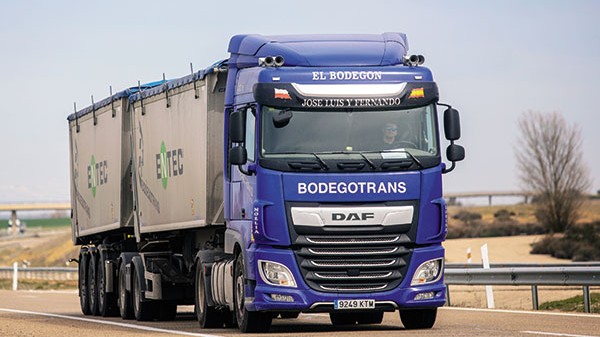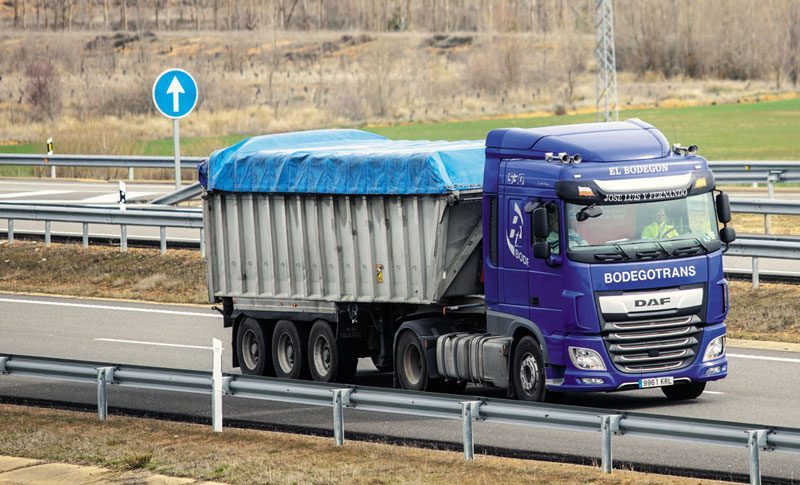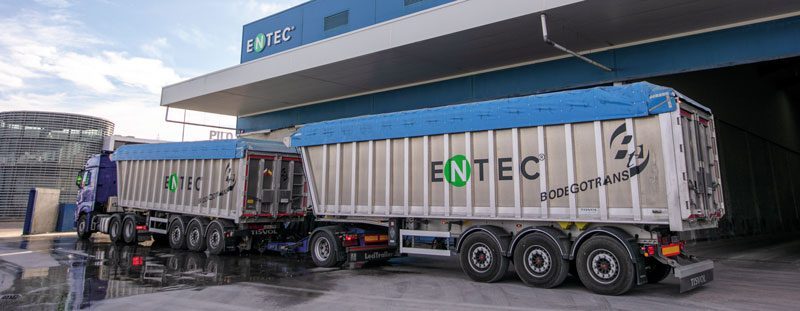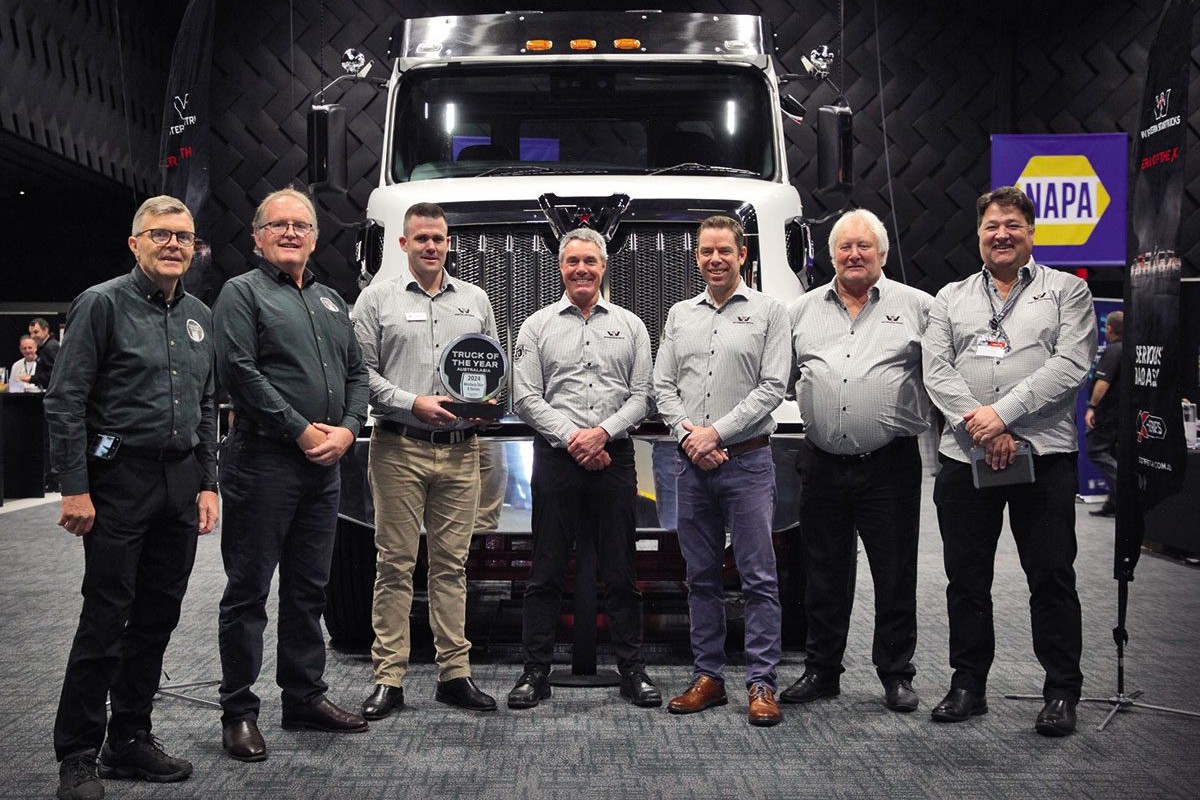Fight of the Titans

European duo-trailer and mega-trailer combinations have attracted their share of misgivings since their first appearance in 2016. However, their efficiency, profitability and reduced emissions per transported load are beyond doubt – they’re here to stay. Let’s find out how the Europeans do HPMV…
The truck’s flexibility, speed and economy has undergone a technological evolution in all its aspects to the point that, during the 1970s, it almost completely replaced rail. In parallel, and as the reliability and power of diesel engines increased, load capacities underwent a similar evolution. Today’s ‘mega-trucks’ are the latest instalment in this incessant pursuit of efficiency, making them another profitable and operational tool for the industry.
These units feature more than six axles, and over 500hp (368kW) power. They don’t exceed 25.25m in length for the mega-trailer and 31.75m for the duo-trailer, while gross vehicle mass is limited to 60 tonne for the former and 70 tonne for the latter.
There are common hindrances that opponents of these units usually put forward. Some say the roading infrastructure is ‘limited’, though nothing could be further from reality. Of course, many European warehouses, scales, loading and unloading areas and so on are certainly not prepared for these giants, penalising the times and the execution of manoeuvres. But it is a mere matter of time before logistics and customers, in general, adapt their structures to achieve a rapid and full operation of the ‘megas’, as is already the case in the countries where they are established.
Another frequent point of friction is the fear that these units will end the need for traditional trailers. This is not true, since there will be a huge number of tasks that they cannot assume due to their very nature or complexity. It is becoming obvious that the large sets will be used solely in the transport of bulk, heavy masses, parcel shuttles or large volumes of merchandise, with the ‘last mile’ as forbidden territory. We must not stop in the face of progress, and the megas, as large articulated trucks, are simply complementary to today’s trailers.
Three-way duel
After seven years, mega trucks have a maturity of use that allows us to compare them with each other and a traditional truck. For this, we have paired up with Spanish bulk transporter Bodegotrans, a family business based in Hinojedo, Cantabria. Bodegotrans’ fleet totals 138 units, of which nine are 60-tonne B-double mega-trailers, and seven are 70-tonne duo-trailers. Our trucks are equipped with tipping buckets.
The ‘David’ of this comparison is the conventional semi-trailer. Made entirely of aluminium with a lift on the first axle and an automatic awning system, it offers a tare weight of only 13.7- tonne and a respectable 26.3- tonne payload. It is paired with a DAF XF 530 tractor, which gives it the highest specific power in the comparison, with 13.25hp/t, and this has been noted in the results since it was the fastest with the lowest consumption.
It is evident that this type of truck will continue to be the majority in transport in general and in the case of bulk goods in particular. It is not for nothing that these are the majority combination in the company’s fleet.
Next up is the 60-tonne B-double mega-trailer set, to date, the most popular alternative due to its flexibility. While it consists of two semi-trailers connected by fifth wheels, as in other countries, it’s used differently in Spain. This is because to meet site deficiencies, the first trailer has been equipped with an extendable double chassis that allows the area of the fifth wheel to be ‘folded’ under the body and so convert it into a conventional semi-trailer. The total length of our aluminium-bodied test unit is 21m.
The mega-trailer is also paired with a DAF XF 530 4×2 that, although offering a favourable tare weight, may be somewhat underpowered for complicated areas but economical on the flat. In our opinion, all large sets should be driven by 6×2 or 6×4 configuration, but the legislation authorises this type.
Finally, the 70-tonne duo-trailer is paired to a Mercedes-Benz Actros 2863, which presents a successful solution with the 6×2 rear tandem – a more rational solution than towing these sets with a 4×2 tractor. With 625hp (460kW), the slopes and Cantabrian ports are met with a specific power of 9hp/t.
The set consists of two conventional 10.7m-long bathtubs that are coupled with a dolly with a twin-wheel axle. The total length reaches 27m.


How do they go?
Our first test route measures 295km, with 35km of regional roads to our delivery point not included in the data collection. We made this decision so that the route was purely on the road and to eliminate the possibility of traffic jams, works or problems on narrow routes.
For its part, the height profile of our test route is the typical one that Cantabrian carriers headed towards the south of the peninsula must face each day. The starting point in Torrelavega is 25m above sea level. We ascend to the Castilian Plateau by the A-67, arriving at Reinosa – 1002m high. Finishing the rest of the trip, we join the A-62 in Venta de Baños to travel along the formerly called Route of the Portuguese until the Cañizal crossroads, 800m away, where we close this first part of the test.
Our second route kicks off at Peñaranda de Bracamonte, loading quartz at the Erimsa mine for the port of Santander. We start the data control at the exit of the town, travelling along the CL-610 road towards Medina del Campo. It’s 54km of regional route with frequent passes through towns. In the Castilian town, we join the A-6 to take the A-62 again in Tordesillas. From Venta de Baños to the end of the test, we rode along the A-67 in the opposite direction to the outward journey, recording 273km under control on the highway. This stage totalled 327km from the loading point to the destination in the Bodegotrans Logística warehouses in Tanos.
The test totalled about 620km (each truck’s tachograph varied slightly), carried out under normal working conditions. It’s fairly representative, with hard ascents and gradients of up to 7% (evident in the average speed and consumption) and the majority on the Castilian Plateau with the consequent increase in speed and reduction in consumption.
Analysing the results reveals a surprising detail; the average speed of the big units does not detract at all from that of the conventional semi-trailer. The 70-tonne duo-trailer kept pace at an average of 83.06km/h, while the 60-tonne B-double averaged 84.32km/h. The ‘control’ unit travelled swiftly, averaging 86.75km/h. The trucks are limited to 90km/h, and the duo trailer to 89km/h. In the descents, the golden minute at 95km/h was taken advantage of to carry inertia and improve the average. There were no surprises in the consumption. The duo-trailer averaged 51.28L/100km (1.95km/L), the mega consumed 47.43L/100km (2.11km/L) and the normal set 34.16L/100km (2.93km/L).

To obtain the profitability of each truck, we first divided the average speed by the average consumption to obtain an efficiency coefficient. The higher the number, the higher the unit’s efficiency. In our test, the most efficient is the traditional trailer, with an outstanding ratio of 2531. It is followed by the mega-trailer with 1778, and the duo-trailer with 1620.
However, the tables are turned when we look for the net profitability data, which is obtained by multiplying the efficiency coefficient by the payload capacity… Here we can appreciate the main argument for the use of larger units. The duo-trailer leads with a ratio of 7450 thanks to its 47-tonne payload. It is followed by the mega-trailer with 6987 at 39 tonnes. The conventional trailer takes a not-distant third with 6656 at 26.3 tonnes of payload.
Given the results of this singular comparison, it’s clear these mega-trailers do not come to threaten the existence of other configurations, but rather it will be the market itself, the customers who decide their employment in the future.
Alberto Puerta is a Spanish commercial vehicle journalist who compiled this report for Spanish ITOY jury member publication Truck.
Read more
All the horses in the race
0 Comments6 Minutes
Stars with the X-factor
0 Comments8 Minutes
Next-level electric
0 Comments12 Minutes






